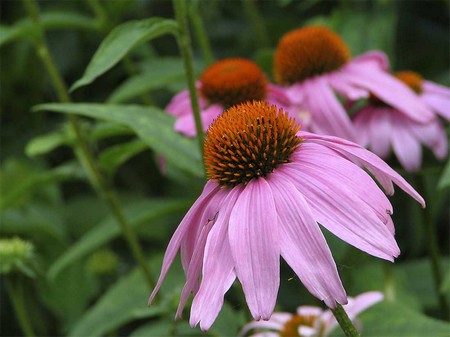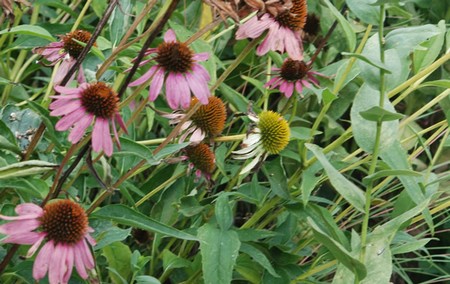The Echinaceas are beautiful plants with pink to purple daisy-like flowers. Their petals fall to reveal black spiny seed heads – the name Echinacea comes from the Greek echinos, meaning hedgehog. Three of the nine species of Echinacea that are native to North America have medicinal benefits. These are E.purpurea, the common purple coneflower E.angustifolia, the narrow-leafed purple coneflower; and E. pallida, the pale purple coneflower. The name coneflower comes from its conical flower beads. Local American names include snakeroot, comb flower, black sampson, Kansas snakeroot, scurvy root, Indian head, black Susan and hedgehog.
Purple coneflower was one of the most important medicinal plants known to the native Americans. They applied it externally to wounds, burns, insect bites and swollen lymph glands and took it internally for headaches, stomach aches, coughs and colds, measles and gonorrhoea. They chewed the root to relieve toothache and neck pain, and commonly used it as an antidote for rattlesnake bites. The root was the part most commonly used, although tribes such as the Comanche, Cheyenne and the Sioux used the juice and a paste of the macerated fresh aerial parts of the plant. The root made a local anaesthetic to deaden sensation and relieve pain. You can feel this on your tongue when taking a few drops of the tincture. The Cheyenne chewed the root to stimulate the flow of saliva, which was particularly useful as a thirst-quencher for those undergoing the ritual Sun Dance. They also drank the tea to relieve rheumatism, arthritis, measles and mumps.
Herbal remedy
Scientific information on the medicinal benefits of Echinaceas comes from two fronts. From 1895 to 1930 American doctors proved the effects of E. angustifolia in a wide range of complaints including boils and abscesses, blood poisoning, post-partum infection, malaria, typhus and TB. German studies over the last 50 years using E.purpurea have proved the remedy to be extremely valuable in septic conditions, rheumatoid arthritis, antibiotic resistance, whooping cough in children, flu, catarrh, chronic respiratory tract infections, gynaecological infections, pelvic inflammatory disease, urinary infections and a variety of skin problems.
Purple coneflower has an antibiotic and antifungal effect, an interferon-like antiviral action and an anti-allergenic action. This means that it can be taken at the first signs of sore throats, colds, chest infections, tonsillitis, glandular fever as well as for Candida and postviral fatigue syndrome (ME). Taken in hot infusion, it stimulates the circulation and stimulates sweating, helping to bring down fevers. As a blood cleanser it will help to clear the skin of infections, and will help to relieve allergies such as urticaria and eczema. It is particularly useful for people whose deficient immune system makes them prone to one infection after another. The anti-inflammatory effect helps relieve arthritis and gout, skin conditions and pelvic inflammatory disease.
Externally, this is a good anti-inflammatory and antiseptic remedy for skin problems, wounds, ulcers, burns, stings and bites. It makes a good gargle and mouthwash for sore throats and infected gums and a douche for a wide range of vaginal infections.
Homeopathic remedy: Echinacea angustifolia
Echinacea angustifolia is used much like the herbal remedy. It is specific for blood poisoning, poisoned wounds, gangrene, boils and carbuncles, septicaemia, diphtheria and the effects of vaccination. It is prescribed for catarrh, abdominal pain and griping, loose yellow stools, diarrhoea, offensive wind and nausea.
An Echinacea person may feel cross and irritable, and does not wish to be contradicted. So nervous they cannot study or concentrate, their head feels dull, and their senses numbed. They may also be depressed and out of sorts, particularly in the afternoon. They generally feel worse after eating, and atter physical and mental exertion and better for rest.
The flower essence
Echinacea is used specifically for those who feel shattered by severe trauma in their lives. They may feel profoundly alienated, unable to contact that inner place of strength and calm. Echinacea helps to bring about a sense of wholeness, and greater resilience when under enormous stress.

